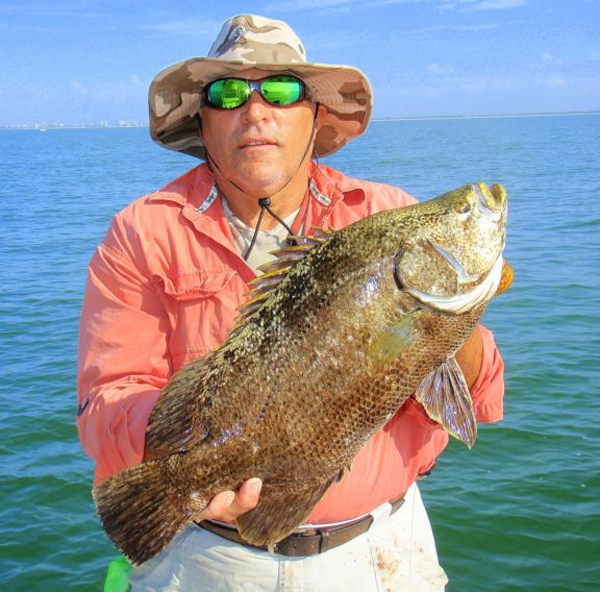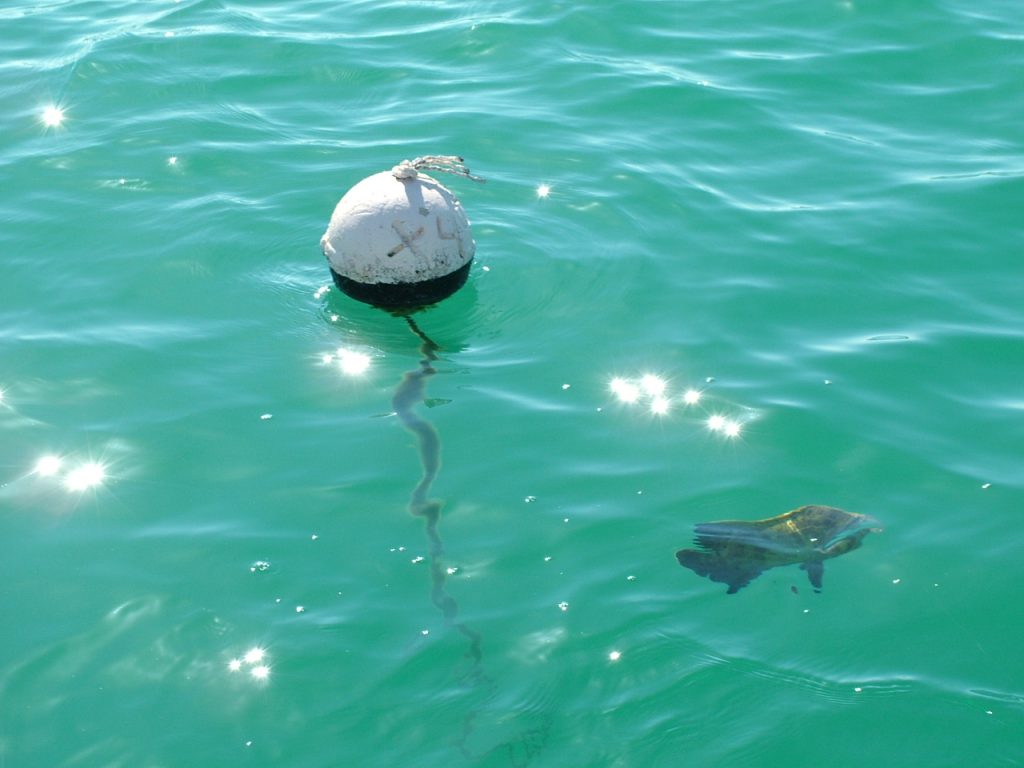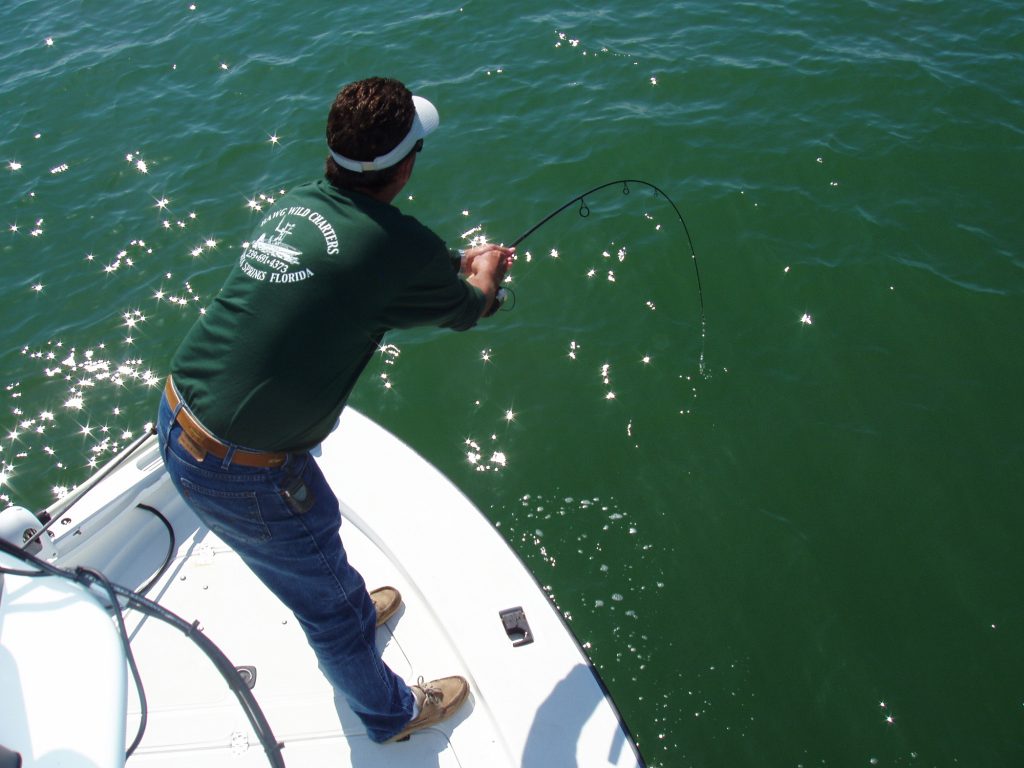February 06, 2017
By David Conway
The fish that'll make you a fool or a fan—tripletail.

In early December of last year I'd had two good days of pompano catching off Juno Pier in windy weather from the north. My third trip that week, arriving pre-dawn, the weather had switched, the waters had calmed, and the sun came up on six or seven big tripletail swimming figure eights around the pier pilings. Only two guys, including me, had fresh shrimp—the slam-dunk bait for tripletail, and we set after them.
After half an hour, I walked off to set up my pompano rods, saying, “Those tripletail will turn on, but who knows when.” Half an hour passed, and the first tripletail hit the planks—landed with my pier net, but not by me. About a 10-pounder. Another 15 minutes, and the second hit the planks, again, in my net. Twelve-pounder, at least. I packed my gear, net and pride safely away and arrived at work by nine o'clock.
Tripletail present about as maddening and joyous a hunt as you'd want in Florida inshore waters. Did I mention that tripletail are considered by many people to be one of the finest, most delectable to fish to eat of all? And that many people outside the Southeast's coastal states do not even know that tripletail exist? Let's keep it that way, okay?
To me, those trips are like floating four-leaf clovers, especially offshore, where you come upon them in sargassum weeds or around flotsam by happenstance, when you're scouting for dolphin, wahoo or tuna. Inshore on both Florida coasts, tripletail follow slightly more predictable migratory patterns up and down the coasts, and on the Southwest coast this time of year, they can actually be pinpoint-targeted by running along the stone crab trap lines, where they hang around the buoys.
Captain Ron Kowalyk, out of South Fort Myers and Weeks Fish Camp, is not only a devoted follower of the fish, but he's one of the tripletail gurus on the Southwest coast.
“In October, the crabbers put their pots out,” says Kowalyk. “By December, it's prime time for trips. One reason I like to run the pots nearshore is that I can do it in my 16-foot skiff and get right along the pots and it's the most fun sight-fishing that we get to do. Once you see the fish, if you're relatively careful, you can get them to eat. They're not as skittish as the backbay fish. Get that shrimp within the strike zone and if the fish goes down, it may even come back up after a few minutes. I like a 2/0 hook, circle hook slightly bent out. We use about 12-pound mono, or 20-pound poly braided, with at least a 3-foot leader. On fly, I've been using a 7- or 8-weight rod, with a butt section and five or six feet of 20-pound fluorocarbon leader, and a shrimp fly. Intermediate sinking tip works, or even a floating line.”
 Those stone crab traps soaking in fall and winter? Check what's hanging on the buoy.
Those stone crab traps soaking in fall and winter? Check what's hanging on the buoy.
I like to think that tripletail, which taste so incredibly good, actually hang around those pots to eat the stone crabs as they enter the traps below. But folks who have cut open more tripletail stomachs than I have tell me that's not the case. Tripletail probably aren't smart enough to use the pots that way, judging by their habit of running underneath your boat to hide when you're trying to target them on a piece of floating structure, and by the company they often keep on those crab buoys and channel markers—cobia. No, tripletail hide by buoys and other floating debris to ambush prey as it nears, and they turn sideways and float on the surface both to camouflage themselves better and soak up the sun's warm rays on cool winter days—making them so much easier for us to spot on calm, low-wind mornings when they surface. (I like the stories of guys offshore just gaffing the barrels and buckets in which the tripletail are hiding and swooping the fish up in nets.)
Tripletail don't just look like oddballs—they are oddballs. Named Lobotes surinamensis for their prevalence around Surinam, in South America, where they were first found in great numbers, they are distributed worldwide, but they are the only fish in their family, Lobitidae, in Gulf and Atlantic waters. Their family name simply springs from the lobe-like shape of their fins. They are available, in their season, in all Florida bay systems and in many rivers, near the inlets. Certainly some bay and inlet systems are known as hotspots—Apalachicola in the spring through early summer, Canaveral and around the St. Lucie and Fort Pierce inlets in the spring and again in the fall, Charlotte Harbor, Englewood and Bonita Springs beginning in December and through the winter, and Florida Bay throughout the cold months.
All across their range, in Florida, and across the Gulf States to Texas, tripletail congregate near large, shallow, sheltered bodies of inshore water. Because they show in better numbers in the southern quarters of Florida in the fall and winter, and along the Panhandle in the spring, anglers and scientists alike have speculated that schools of tripletail follow a north-south coastal migration similar to that of their buoy-buddy, the cobia.
 Fighting a nice tripletail on the Gulf coast.
Fighting a nice tripletail on the Gulf coast.
Or do they? One of the leaders in tripletail research in the country, Read Hendon, Assistant Director of Fisheries at the Gulf Coast Research Laboratory at the University of Southern Mississippi, has gleaned from tagging that while tripletail schools make migrations along the coasts with the seasons, the hotspot locations may be the main meeting grounds of entirely separate populations of spawning aggregations of tripletail.
“By now we're getting a little glimmer of light about how tripletail move around,” Hendon says. “Earlier we believed that they followed a similar migratory route as cobia along the coastline. However, we now think they probably exhibit more of an onshore-offshore migration. The problem is that we don't have a lot, or actually, any fish tagged and caught offshore. We assume that when they're not on the coasts that they are offshore. We have seen rare instances of extended movements along the coastline. One tagged in Canaveral was recaptured in Topsail Beach, North Carolina.
“There've been three or four instances of Naples fish recaptured in Apalachicola Bay. But we've had no fish tagged off, say, Apalachicola, and caught in Alabama or Mississippi. So we think we may be looking at geographically distinct groups of tripletail.”
In comparison to other widely available, tasty fish, very little is known about the tripletail's biology, and Hendon believes that's because tripletail fishing hasn't been all that popular (except in isolated locales along the Gulf Coast and in Florida)—until the last few years, and due to the lack of a directed commercial fishery for them. They're still a bit beguiling to researchers.
“Hundreds of miles into the Gulf in sargassum,” Hendon says, “we'll find tripletail in all its life stages, and at the same time, you'll find them close to freshwater sources. Overall, our thinking is that they will move offshore as the waters cool, and then they'll come back in when the water warms up. We do know that in Canaveral people will catch them over reef-like structures in 40 and 50 feet of water.”
Not to say that you won't occasionally find them free-swimming in the surf zone, especially near inlets and bays where they can be caught in good numbers (southeast Georgia's Jekyll Island and St. Simons Island springtime tripletail bite is well-known and they're commonly caught in the surf there) but tripletail are known to be drawn to structure—on the surface, at piers, or by docks and rocky bottom structure in those bays and river systems.
If you're on the hunt for them, bring live shrimp, and cast to the fish on the surface with a shrimp on a float-rig for an easy presentation, or freeline that shrimp. Folks who see a lot of tripletail, like those on the Southwest coast, even break out the fly rods. Same drill goes for offshore—lob a shrimp their way and prepare a clear path to get the fish free from its hideout. For tripletail that haven't seen many anglers, even a jig tipped with a small piece of white rag will work. Inshore, around markers, buoys (crab or stone, or lobster to the south) and docks, if you don't see them at the surface, make sure to drop a jig or a shrimp down to the bottom as you drift. Tripletail aren't always on the surface showing off. Fifteen pounds is a big trip, but they grow to 40 pounds. Fifteen inches is the minimum legal size, and the Florida bag limit is two per person. Oh, and I'll be back on that pier this December.
Tagging Tripletail
Captain Dave Lanier of Alibi Charters and owner of Hickory Bait & Tackle in Bonita Springs (239-498-0090) has been tagging tripletail (and cobia) for about five years now, after reading about the tagging program on the FS Forum.
“I read up on the tagging program, which is run by Professor Hendon of the University of Southern Mississippi, and I started right up with it,” said Lanier. “We catch a lot of tripletail around here, year-round, around the swim buoys, but once those pots get some time on them, they attract the biggest tripletail of the year. They present quite a good challenge, no matter their size. If he's small, I'll still go after him. But he'll get tagged.”
Once Capt. Lanier catches a tripletail and determines what he'll do with it, if it's not going home for dinner, then he'll get to tagging.
“It's a really simple process on the water, doesn't hurt the fish, and it does a great deal for the research into the patterns and migrations of the tripletail species. I've even seen the tags sticking out of fish while they are free-swimming in the water. Plus, if you send five cards in a year you get a nice T-shirt.”
Lanier emphasized the importance of calling in the catch of a tagged fish.
“You may someday come upon a tagged fish, and if you catch one, tripletail or cobia, be sure to call the 800 number on that tag. They are going to want to know all about the fish, and in return they can share all the info about that fish's history. That's what the tagging program is all about.”
Also, if you're going to release that fish, don't remove the tag. Copy the 800 number and the serial number from the tag, and call that tag number in. Let the fish go with that tag. If he's released each time, then researchers can get a really complete picture of this fish.
The Gulf Coast Research Laboratory's tripletail tagging program started in the mid-‘90s, but wasn't directly funded until 2001, with grants from the U.S. Fish & Wildlife Service Sportfish Restoration Program, through the state of Mississippi, which still funds it today.
“We really got started in Florida, in Cape Canaveral and Charlotte Harbor,” said Read Hendon, the program director. “One commercial crabber helped us out immensely by tagging over 1,000 tripletail in four years, and now the program has grown and this year we had really good growth in the number of anglers participating in the north central Gulf.”
Hendon believes that the increasing popularity of tripletail fishing may lead to a parallel increase in our knowledge about the fish.
“We've been locally working trying to get some size and bag limits in Mississippi and Louisiana, and these states are considering this possibility. Alabama has a 3 per person, 16-inch minimum length rule. As tripletail fishing gets more popular, limits will be really crucial. Based on reproductive studies, the size at which 50 percent of female tripletail are sexually mature is approximately 18 inches and 100 percent of the females are sexually mature at approximately 20 inches. These are north central Gulf fish. Generally speaking, you want to give the fish the chance to spawn. Right now, the management regime is wide-ranging among states, and in many places, anglers are regulating themselves by imposing their own size and bag limits, which is terrific to see.
“Overall, it's been a wonderful program where we manage the data and provide the tagging materials, but the anglers are really doing all the crucial research. We like to say it's your project, and really it is.”
To learn more about the tagging programs run by the Gulf Coast Research Laboratory at the University of Southern Mississippi, led by Read Hendon, Assistant Director of Fisheries there, e-mail read.hendon@usm.edu; see www.usm.edu/gcrl or call (228) 872-4202.
First Published in Florida Sportsman Magazine, December, 2009
